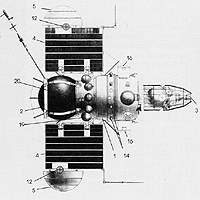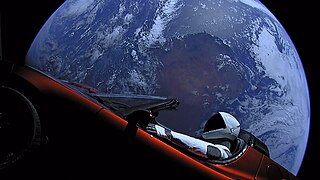
Venera 2MV-1 No.1, also known as Sputnik 19 in the West, was a Soviet spacecraft, which was launched in 1962 as part of the Venera programme.
Venera 2MV-2 No.1, also known as Sputnik 21 in the West, was a Soviet spacecraft, which was launched in 1962 as part of the Venera programme, and was intended to make a flyby of Venus. Due to a problem with the rocket which launched it, it failed to leave low Earth orbit, and reentered the atmosphere a few days later. It was the second Venera 2MV-2 spacecraft, both of which failed to leave Earth orbit.

This article outlines notable events occurring in 2005 in spaceflight, including major launches and EVAs. 2005 saw Iran launch its first satellite.

Spaceflight began in the 20th century following theoretical and practical breakthroughs by Konstantin Tsiolkovsky, Robert H. Goddard, and Hermann Oberth. First successful large-scale rocket programs were initiated in the 1920s Germany by Fritz von Opel and Max Valier, and eventually in Nazi Germany by Wernher von Braun. The Soviet Union took the lead in the post-war Space Race, launching the first satellite, the first man and the first woman into orbit. The United States caught up with, and then passed, their Soviet rivals during the mid-1960s, landing the first men on the Moon in 1969. In the same period, France, the United Kingdom, Japan and China were concurrently developing more limited launch capabilities.

Soyuz-2 is a modernized version of the Soviet Soyuz rocket. In its basic form, it is a three-stage launch vehicle for placing payloads into low Earth orbit. Compared to the previous versions of the Soyuz, the first-stage boosters and two core stages feature uprated engines with improved injection systems. Digital flight control and telemetry systems allow the rocket to be launched from a fixed launch platform, whereas the launch platforms for earlier Soyuz rockets had to be rotated as the rocket could not perform a roll to change its heading in flight.

Several significant events in spaceflight occurred in 2009, including Iran conducting its first indigenous orbital launch, the first Swiss satellite being launched and New Zealand launching its first sounding rocket. The H-IIB and Naro-1 rockets conducted maiden flights, whilst the Tsyklon-3, Falcon 1 and Ariane 5GS were retired from service. The permanent crew of the International Space Station increased from three to six in May, and in the last few months of the year, Japan's first resupply mission to the outpost, HTV-1, was conducted successfully.

The year 2011 saw a number of significant events in spaceflight, including the retirement of NASA's Space Shuttle after its final flight in July 2011, and the launch of China's first space station module, Tiangong-1, in September. A total of 84 orbital launches were conducted over the course of the year, of which 78 were successful. Russia, China and the United States conducted the majority of the year's orbital launches, with 35, 19 and 18 launches respectively; 2011 marked the first year that China conducted more successful launches than the United States. Seven crewed missions were launched into orbit during 2011, carrying a total of 28 astronauts to the International Space Station. Additionally, the Zenit-3F and Long March 2F/G carrier rockets made their maiden flights in 2011, while the Delta II Heavy made its last.
Meridian 2, also known as Meridian No.12L, was a Russian communications satellite. It was the second satellite of the Meridian system, which replaced the older Molniya series. It followed on from Meridian 1, which was launched in December 2006.
Progress M-17 was a Russian uncrewed cargo spacecraft which was launched in 1993 to resupply the Mir space station. The thirty-fifth of sixty-four Progress spacecraft to visit Mir, it used the Progress-M 11F615A55 configuration, and had the serial number 217. In addition to delivering cargo, Progress M-17 was also used to demonstrate extended duration Progress missions; remaining in orbit for almost a year with a docked phase lasting 132 days.
Kosmos 321, also known as DS-U2-MG No.1, was a Soviet satellite which was launched in 1970 as part of the Dnepropetrovsk Sputnik programme. It was a 365-kilogram (805 lb) spacecraft, which was built by the Yuzhnoye Design Bureau, and was used to investigate the magnetic poles of the Earth.
Kosmos 356, also known as DS-U2-MG No.2, was a Soviet satellite which was launched in 1970 as part of the Dnepropetrovsk Sputnik programme. It was a 357-kilogram (787 lb) spacecraft, which was built by the Yuzhnoye Design Bureau, and was used to investigate the magnetic poles of the Earth.

In 2015, the maiden spaceflights of the Chinese Long March 6 and Long March 11 launch vehicles took place.

This article documents notable spaceflight events during the year 2019.

Notable spaceflight activities in 2017 included the maiden flight of India's Geosynchronous Satellite Launch Vehicle Mark III on 5 June and the first suborbital test of Rocket Lab's Electron rocket, inaugurating the Mahia spaceport in New Zealand. The rocket is named for its innovative Rutherford engine which feeds propellants via battery-powered electric motors instead of the usual gas generator and turbopumps.

This article documents notable spaceflight events during the year 2018. For the first time since 1990, more than 100 orbital launches were performed globally.
Aist 1 is a Russian technology demonstration satellite which was launched in December 2013. Aist 1 is operated by the Samara Aerospace University, who constructed it in partnership with TsSKB Progress. It is the second launched Aist satellite, following Aist 2's April 2013 launch.
Foton-M No.4 is a Russian microgravity and bioscience research spacecraft launched in July 2014 as part of the Foton programme. It is the fourth spacecraft in the Foton-M series, and the first to use the 34KSM configuration incorporating the equipment module from a Yantar satellite in place of that of a Zenit on earlier missions.

This article documents notable spaceflight events during the year 2020.

This article documents expected notable spaceflight events during the year 2026.

This article documents expected notable spaceflight events during the year 2025.












